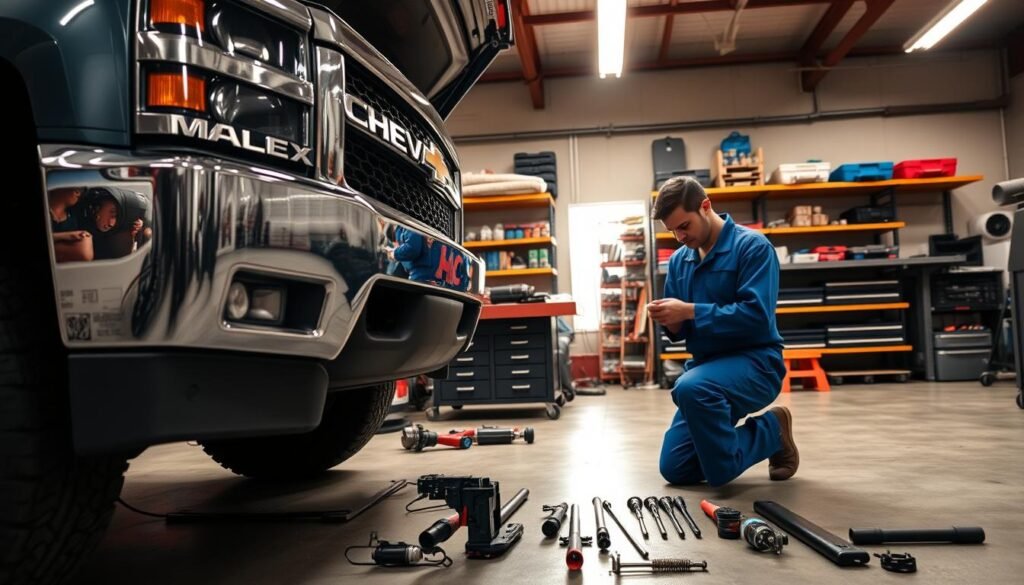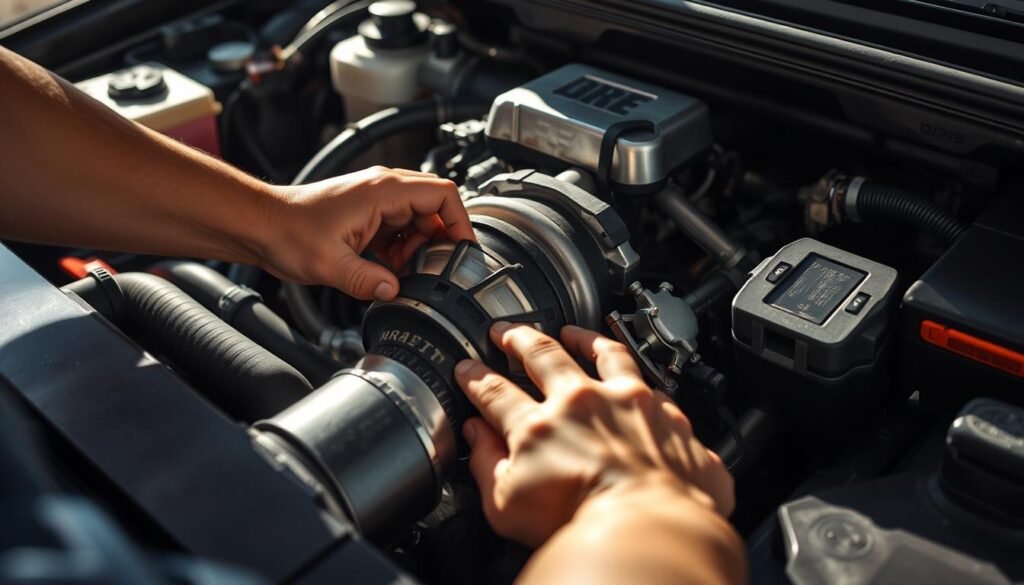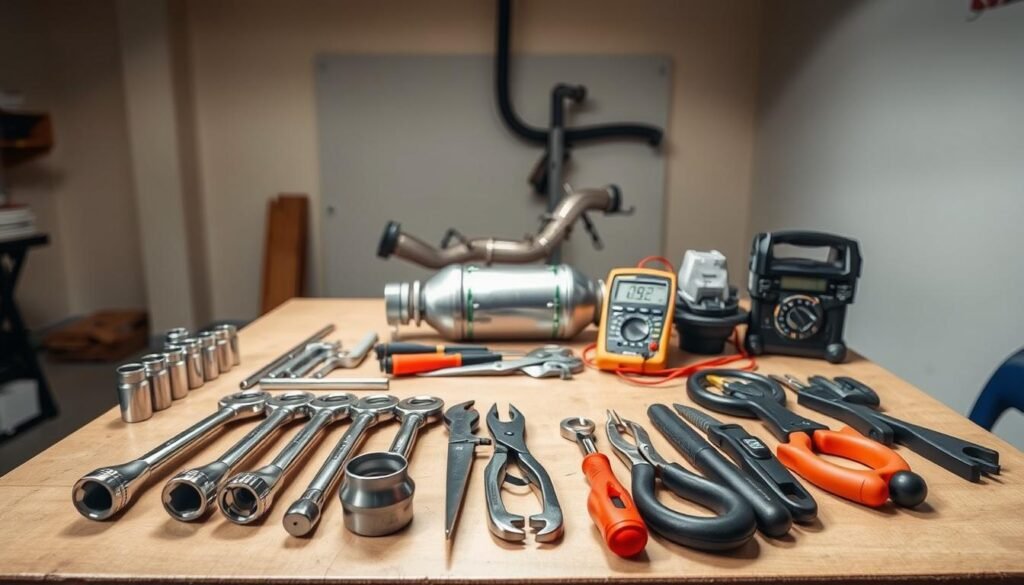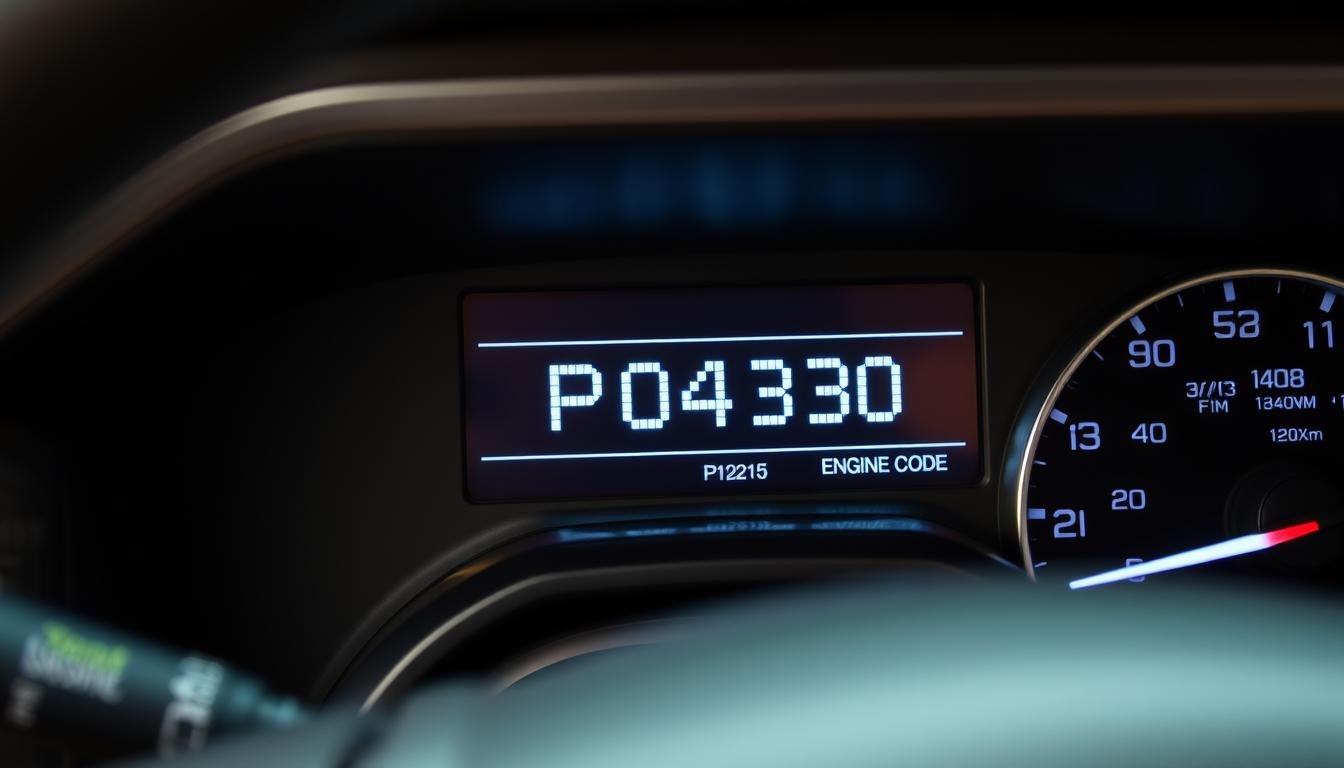P0430 Code Chevy Silverado – Fix & Prevention Tips
The P0430 code in a Chevy Silverado points to a catalytic converter problem. If this is your issue, you’re not by yourself.
Knowing about this code is key to keep your vehicle running well. We’ll cover symptoms to look for, causes like bad oxygen sensors or leaks, and ways to fix the P0430 code.
Our advice will also help you lessen the risk of getting this code again. Get ready to learn how to handle this problem with confidence.
Whether you fix it yourself or get help from a pro, you’ll learn how to make your Silverado last longer and work better.
What is The P0430 Code?
The P0430 code is crucial in the On-Board Diagnostics II (OBD-II) system in modern cars, like the Chevy Silverado.
It tells us there’s a problem with the catalytic converter’s efficiency. For the Chevy Silverado, this engine code means the catalytic converter isn’t working as well as it should.
This part is key in cutting down harmful emissions. Knowing about the P0430 code helps keep your car running right and following environmental rules.
A bad catalytic converter can cause more pollution and problems for your Chevy Silverado. Fixing this issue quickly helps avoid bigger repairs later.
What is The P0430 Code?
The P0430 code means there’s a problem with your Chevy Silverado’s catalytic converter on Bank 2. It shows that the converter isn’t working as well as it should.
Many things can cause this issue. One main cause of this code is faulty oxygen sensors. These sensors are key in checking the exhaust gases.
If they don’t work right, the readings on the converter’s performance might be wrong. Also, the catalytic converter itself might fail.
This can make your vehicle run poorly and maybe harm the engine if it’s not fixed quickly. It’s important to understand what the P0430 code means.
Dealing with it fast can prevent bigger issues. This helps keep your engine running smoothly and keeps your vehicle in good shape.
P0430 Code Chevy Silverado: Symptoms of The Problem
When your Chevy Silverado shows the P0430 code, it’s important to spot the P0430 code symptoms. They can range from minor annoyances to major problems.
These signs affect how your vehicle works and feels on the road, hurting your Chevy Silverado performance.
Common Symptoms To Watch For
- Illuminated check engine light
- Decreased fuel efficiency
- Unusual noises from the exhaust system
- Sluggish acceleration
- Poor engine performance
Impact on Vehicle Performance
The P0430 code symptoms might lower your Chevy Silverado’s performance. Ignoring them can lead to worse issues.
You may find your truck using more gas, moving slower, or emitting more pollution. Fixing these problems quickly can save money and improve how your truck runs.
P0430 Code Causes
Getting to the bottom of the P0430 code is key for fixing it right. Often, the trouble starts with bad O2 sensors. These sensors might not read things correctly.
Wrong readings can mess with how your car manages fuel. This can hurt your car’s performance more.
Exhaust leaks are another big problem. They change how exhaust moves and can hurt your catalytic converter’s work.
Also, if your catalytic converter is damaged or worn out, it can set off the P0430 code. This points to it not working as well as it should.
Defective O2 Sensors
O2 sensors going bad are a common reason behind the P0430 code. If they’re not working right, they send wrong info to the engine’s computer.
This can mess up the mix of air and fuel. That messes with how well your car runs and its gas mileage.
If you have a Check Engine Light or your car runs rough when it’s cold, O2 sensors might be why.
Exhaust Leaks and Their Role
Exhaust leaks hurt your car’s exhaust system’s work. They mess up the flow, causing problems that might lead to the P0430 code.
You may hear more noise from your exhaust or see your engine’s performance drop. Checking for leaks often can help keep your exhaust system working right.
Issues with Catalytic Converter
Problems with your catalytic converter can cause the P0430 code too. If it’s hurt or worn down, it won’t control emissions well.
Keeping an eye on your catalytic converter is key. If you don’t fix issues, your car’s exhaust system could get seriously damaged in the long run.
How To Diagnose The P0430 Code?
Diagnosing the P0430 code means checking your car’s exhaust system carefully. You start by using an OBD-II scanner.
This tool gets the error code from the car’s computer. It shows what might be wrong. Then, inspect the exhaust for damage or leaks.
Using an OBD-II Scanner
To start diagnosing, hook up an OBD-II scanner to your car. This gadget pulls trouble codes from the car’s computer.
Connect it under the dashboard and follow the instructions to get the codes. If the P0430 code shows up, it means there’s a problem with the catalytic converter.
Also, look out for any other codes that could tell more about the exhaust’s condition.
Visual Inspection of Exhaust Components
After using the scanner, inspect the exhaust parts. Look at the catalytic converter and O2 sensors for damage like dents or rust.
Check the connections and gaskets for any leaks. This inspection helps spot clear issues and adds to what the scanner already showed.
By combining scanner data and a visual check, you can accurately figure out the P0430 code. This approach helps you know what to fix in your car’s exhaust system.
P0430 Code Fix: Repairing The Issue
For a successful P0430 code fix in your Chevy Silverado, find and fix the bad parts. Doing this repair right not only solves the code problem.
It also makes your vehicle run better. Mainly, you need to check two areas: the oxygen sensors and the catalytic converter.
Replacing Oxygen Sensors
Bad O2 sensors often cause the P0430 code. Changing these sensors usually isn’t hard and helps with your car’s emissions.
Just follow these steps:
- Use an OBD-II scanner to find which O2 sensors are bad.
- Turn off the battery for safety when you swap them out.
- Take out the old sensor(s) with a wrench.
- Put in new, good-quality oxygen sensors and reconnect everything well.
- Use the scanner to clear the code and then test drive your car.
Replacing The Catalytic Converter
Need to swap the catalytic converter? This job is usually harder and costs more due to work and parts.
Think about these points:
- Make sure it’s really the catalytic converter that’s the problem to avoid emissions issues.
- Have the right tools and parts ready before you start.
- Disconnect the exhaust system and sensors linked to the catalytic converter.
- Replace it with a new, dependable one.
- Hook everything back up and double-check your work to make sure it’s right.

Preventing The P0430 Code
Stopping the P0430 code in your Chevy Silverado starts with solid vehicle upkeep. Keeping up with maintenance boosts the health of the exhaust.
t also helps vital parts like the catalytic converter and oxygen sensors last longer.
Regular Maintenance Tips
- Check the exhaust system regularly for any leaks or damage.
- Quickly replace damaged or old oxygen sensors to keep them working well.
- Make sure the catalytic converter isn’t blocked and works right with regular checks.
Monitoring Exhaust System Health
Pay attention to your exhaust system’s condition. Checking it often lets you find problems early. This helps stop the P0430 code. When inspecting, focus on these points:
- Look for leaks that could hurt the engine’s performance.
- Ensure oxygen sensors accurately measure oxygen to keep the catalytic converter working well.
- Watch for signs of poor fuel efficiency and high emissions.
Using Quality Fuel and Parts
Using top-notch fuel helps the exhaust system stay clean. Choose well-known brands that fit your car’s needs to avoid deposits that can damage the catalytic converter and sensors.
Also, use OEM or quality aftermarket parts for replacements to keep your car running smoothly.
Cost Implications of Fixing The P0430 Code
Dealing with a P0430 code means knowing what costs to expect. Repair costs can widely vary, based on what needs fixing.
The type of parts and labor costs in your area play a big role in the total expense.
Budgeting For Repairs
To budget for repairs, consider all possible costs of fixing the P0430 code. Think about:
- Replacement of O2 sensors
- Cost of replacing a catalytic converter
- Diagnostic fees for follow-up assessments
A good budget covers both parts and labor costs. This helps in setting aside enough money for repairs. It also reduces the stress from surprise bills.
Learning Parts and Labor Costs
Knowing the costs of parts and labor is key. Parts needed for the P0430 code can have different prices:
| Part | Average Cost ($) |
|---|---|
| O2 Sensor | 100 – 200 |
| Catalytic Converter | 300 – 2,500 |
Labor costs change based on where you are and the shop’s rates. They usually range from $75 to $150 per hour.
Knowing these costs helps in creating an accurate budget for fixing the P0430 code.

Real-Life Case Study: Fixing A P0430 Code
A vehicle owner faced the P0430 code and found a solution that might help others. This case study shows how to tackle this problem step by step.
It highlights the need for careful diagnosis and fixing things the right way.
Step-by-Step Troubleshooting Process
The owner started by checking the code with an OBD-II scanner. Then, they looked closely at the exhaust parts.
They performed several checks, including:
- Looking over the exhaust system for leaks.
- Checking the oxygen sensors for damage or failure.
- Finding any problems with the catalytic converter related to emissions.
The owner found and replaced a faulty O2 sensor. This sensor plays a big role in checking the exhaust gases, which affects how the engine runs and the emission levels.
Success Story: Thriving After Repair
After fixing the problem, the car ran much better. This success story shows the benefits of careful troubleshooting of the P0430 code.
The owner’s detailed work fixed the current issue and might stop future problems. It’s a great example of how doing repairs carefully can make a car more reliable.
Tools Needed For P0430 Code Repair
Fixing a P0430 code on your Chevy Silverado requires the right tools. These tools help in pinning down problems accurately and safely.
Here’s a list of must-haves and safety tips for your repair work.
Essential Tools For Diagnosis and Repair
To fix the P0430 code, you’ll need some key tools:
- OBD-II Scanner: This tool is vital for reading diagnostic trouble codes.
- Wrenches: A range of wrenches, including socket and torque wrenches, are necessary for various parts.
- Spark Plug Tap: Useful for repairs related to faulty connections.
- Safety Goggles: Protects your eyes from debris while working.
- Gloves: Ensure safety while handling potentially hazardous materials.
Safety Equipment and Precautions
Staying safe while repairing is crucial. Here are some important safety steps:
- Wear gloves and goggles to protect your skin and eyes during repairs.
- Work in a well-ventilated area to avoid inhaling harmful fumes.
- Ensure your vehicle is securely parked and on a level surface before starting repairs.
- Disconnect the battery to prevent electrical shocks while working on the electrical system.

P0430 Code: Chevy Silverado Specifics
The P0430 code reveals problems in many Chevy Silverado models. It means “Catalyst System Low Efficiency Bank 2.” It’s common in various years. Knowing the differences can help fix your car better.
Common Issues Across Different Silverado Models
Each model year of Silverado has its own set of P0430 issues. For instance, 2014 models often have this problem, even after changing parts like oxygen sensors and catalytic converters.
It’s important to look at other possible causes such as exhaust issues, O2 sensor wiring, or the Engine Control Module (ECM).
Learning Model Year Variances in Repairs
Chevy Silverados’ emissions systems have improved over the years. This means the parts and repair methods have changed too.
By knowing these changes, you can better identify and fix issues, leading to more successful repairs.
Expert Tips For Chevy Silverado Owners
Fixing your Chevy Silverado can seem tough. It’s important to know when to fix things yourself or call a pro. With the right tips, you can make smart choices for your truck.
When To Seek Professional Help
Some fixes need special know-how or tools you might not have. If you keep running into problems, especially with the exhaust, it’s smarter to get professional help.
Think about these points:
- How complex the repair is
- If you have the right tools
- Your experience level
- How much time you have
DIY vs Professional Repairs
Knowing when to do it yourself or hire a pro can save you time and cash. Think about the good and bad of each choice:
| Aspect | DIY Repairs | Professional Repairs |
|---|---|---|
| Cost | Less money at first, but mistakes can cost more later | More money up front, but less chance of extra repairs later |
| Time | Takes longer, especially if you’re new to this | Professionals can fix things quicker with their tools and know-how |
| Skill Required | Most owners can handle basic fixes | Pros are needed for complicated repairs |

Conclusion
Knowing about the P0430 code is key for Chevy Silverado owners. It helps keep your car running well for longer.
This summary talked about the signs, causes, and how to fix related problems. Spotting these issues early can help you save on repair costs.
Doing regular checks, especially on the exhaust system, is very important. Use high-quality parts for the best results.
The tips we shared will help you deal with P0430 code problems efficiently. This leads to a smoother drive and a better car performance.
Taking good care of your car and learning about the P0430 code can make a big difference.
With the correct info and tools, you can maintain your vehicle’s excellent condition. This means a smoother ride for many miles.
FAQs
What does the P0430 code mean for my Chevy Silverado?
The P0430 code shows a problem with your Chevy Silverado’s catalytic converter on Bank 2. It might not work right, leading to higher emissions.
What are the symptoms of a P0430 code in a Chevy Silverado?
If you have a P0430 code, you might see the check engine light. Your truck might use more fuel and not drive smoothly. You might also hear odd noises from the exhaust.
How can I diagnose the P0430 code?
First, use an OBD-II scanner to find the error code. Check the exhaust system and catalytic converter for damage or leaks.
What are the common causes of a P0430 code?
The P0430 code can happen because of bad oxygen sensors or leaks. Damage to the catalytic converter is also a common cause.
What steps are involved in fixing the P0430 code?
To fix the P0430 code, you might need new O2 sensors or a new catalytic converter. Use good parts for better performance and longevity.
How can I prevent the P0430 code from reoccurring?
Keep your exhaust system well-maintained. Use good fuel and replace old parts on time. Also, check your sensors regularly to keep everything running right.
What costs should I consider when addressing a P0430 code?
The cost to fix the P0430 code includes parts and labor. Know the prices for O2 sensors and catalytic converters to plan your budget.
When should I seek professional help for a P0430 code issue?
If fixing exhaust system problems is too hard for you, or if the problem is complex, see a pro. They can make sure it’s done right.







